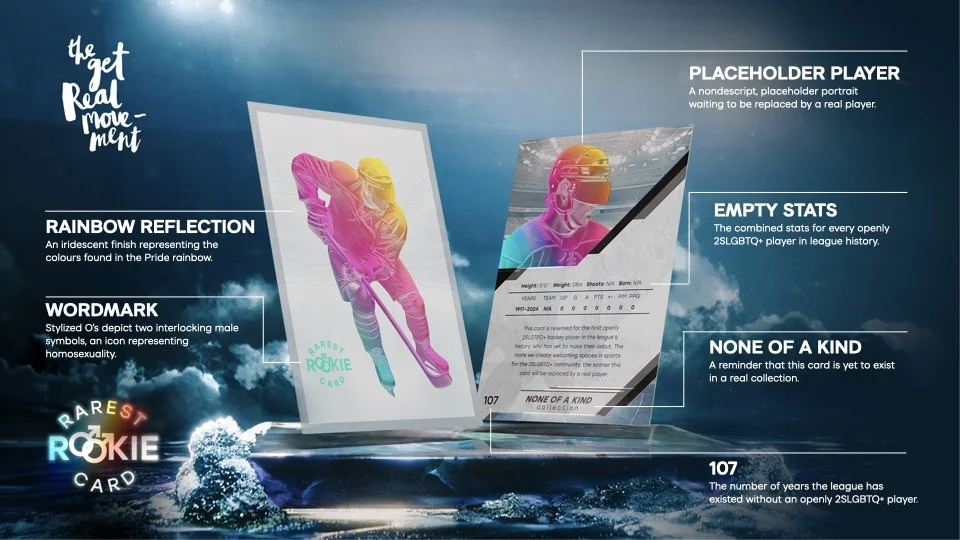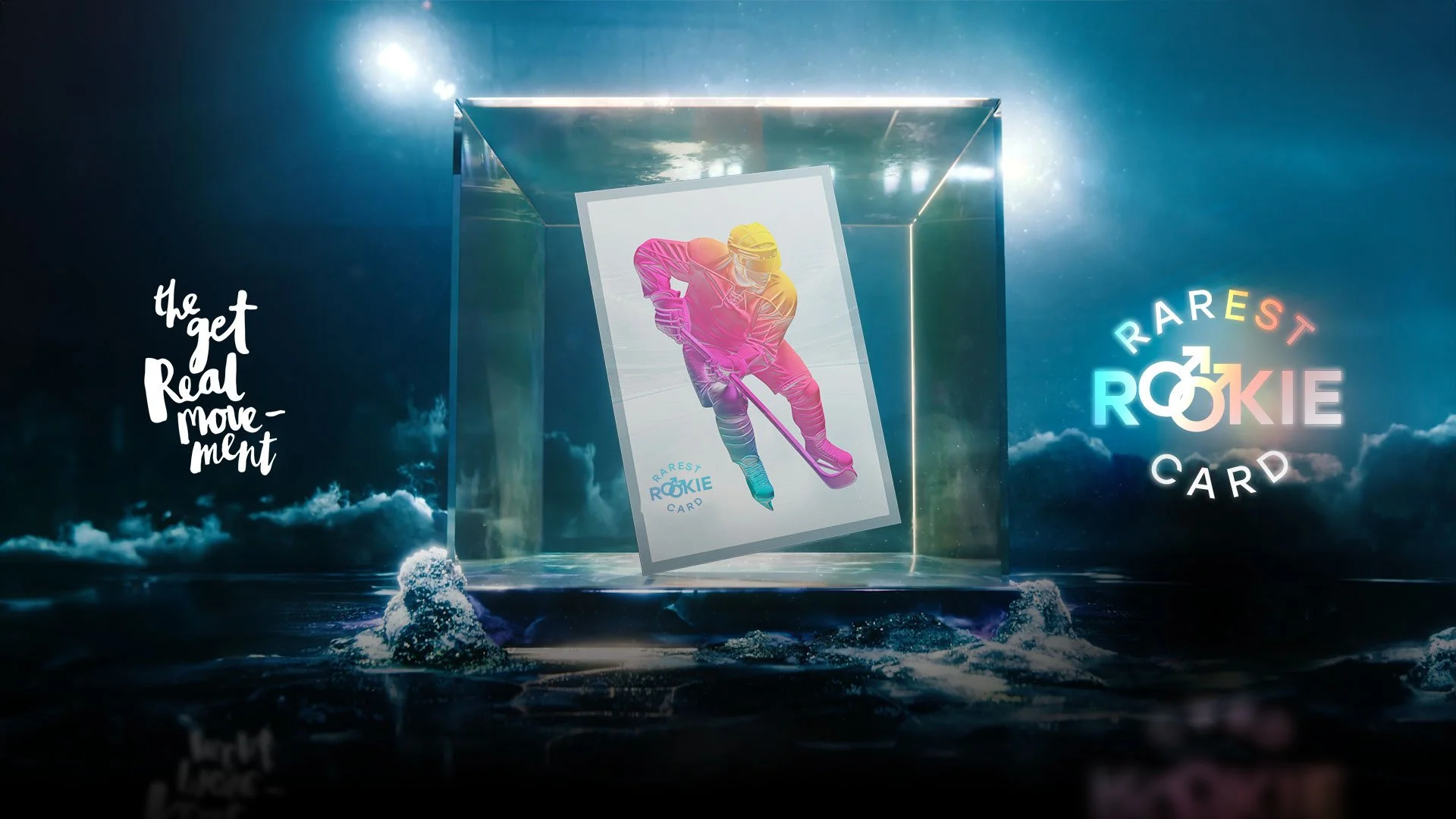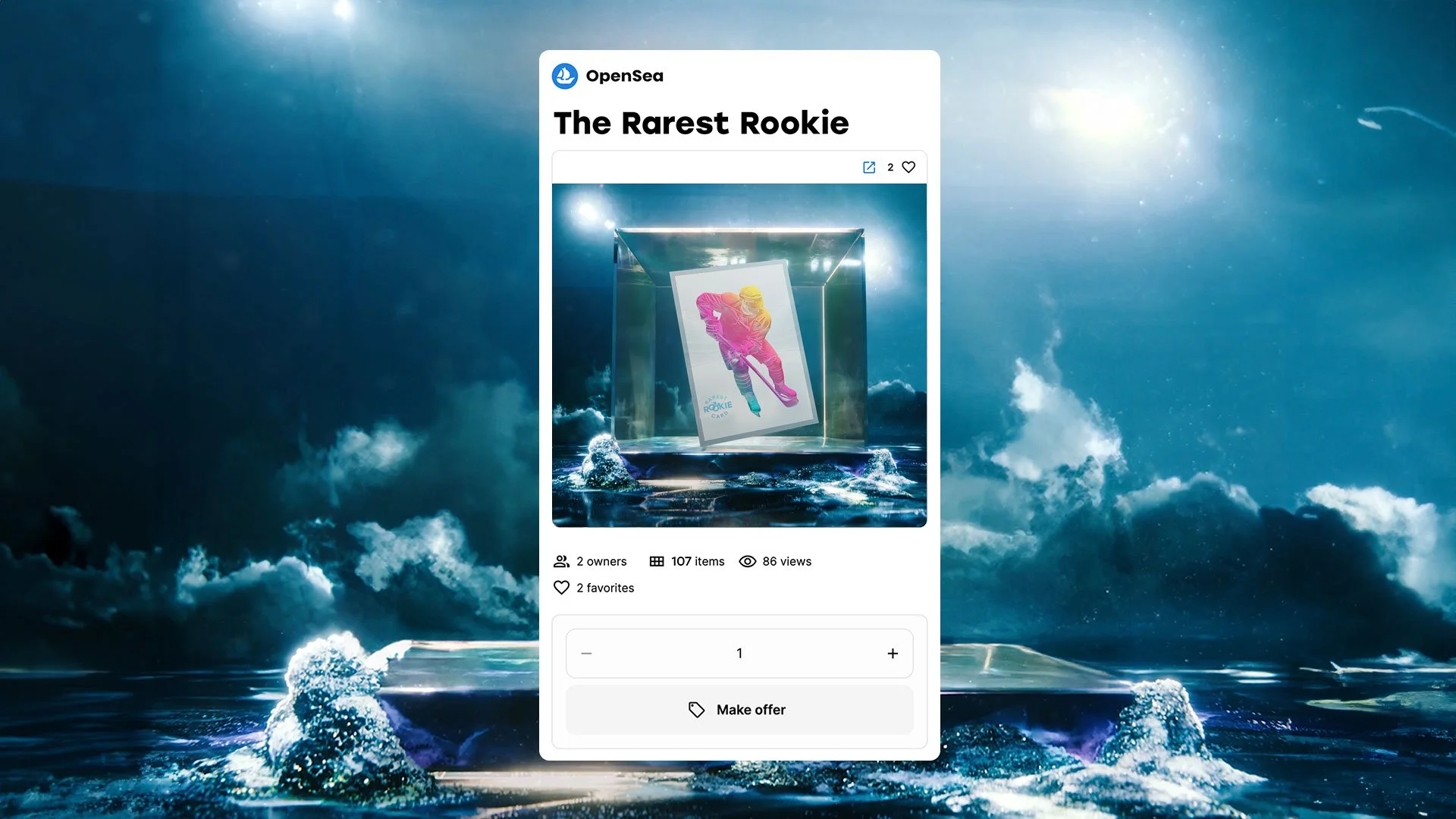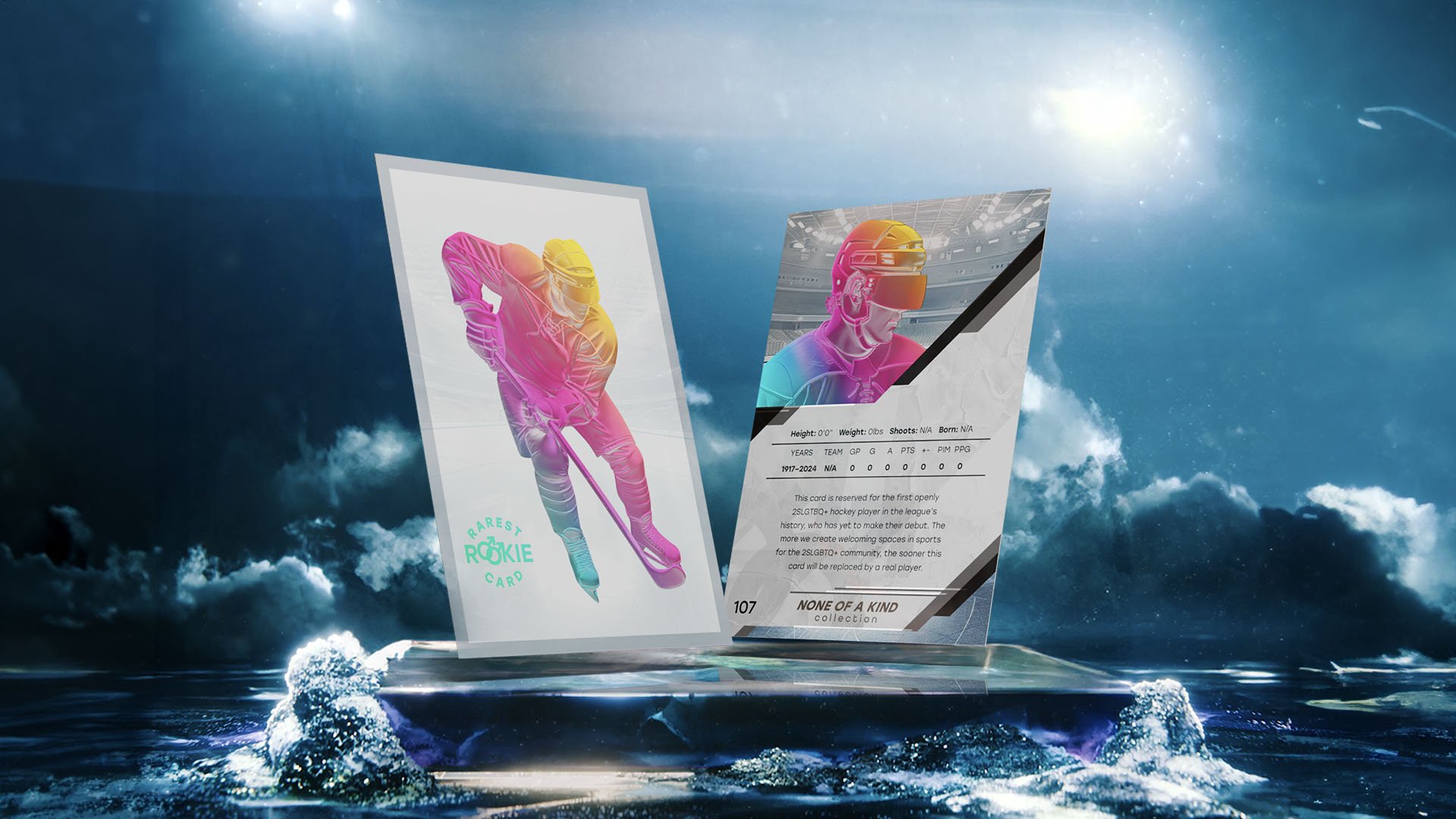
Rarest Rookie Card
a rookie card reserved for the league’s first openly 2SLGBTQ+ player
On National Hockey Card Day, we will be releasing the ”Rarest Rookie Card”: an incomplete hockey card for an unidentifiable player which we hope it will not only raise awareness of the lack of 2SLGBTQ+ representation in the league, but will also foster a culture of support and inclusivity, acting as a catalyst for the first openly 2SLGBTQ+ identified player to make their debut.
107 digital collectable cards are being released as NFTs on the marketplace OpenSea with the proceeds of each card’s sale going towards our mission of creating safe spaces in sports for the 2SLGBTQ+ community.
The digital card reimagines features found on other specialty hockey cards, with embossed player details, a set of blank statistics and a metallic ink finish which gives off a rainbow shimmer when tilted towards the light, evoking the colours of Pride. Emblazoned on the card are the words, “Rarest Rookie Card,” with the two O’s in “rookie” being used to create interlocking male icons: a symbol representing homosexuality.
The plan is to replace the faceless player on each of the cards once the unidentified player makes his debut, which we hope is sooner rather than later.
“We want to see a game where everyone feels welcome: on the ice, in the dressing room and as fans in the stands.”
-MARLEY BOWEN, OUR EXECUTIVE DIRECTOR
The NHL is the last of the “Big Four” professional sports leagues to count an openly 2SLGBTQ+ player among its ranks, trailing behind the MLB, NFL and NBA.
In 2021, Nashville Predators prospect Luke Prokop broke barriers when he became the first openly gay player under NHL contract, but he has yet to make his NHL debut.
In the world of collectibles, rarity is what gives a sports card its value. Earlier this year, an unopened case of hockey cards fetched over $5 million at auction because they likely contained several extremely rare Wayne Gretzky rookie cards. But there’s one occurrence so rare that no player in the NHL’s 107-year history has ever laid claim to it: being the league’s first openly 2SLGBTQ+ identified player.
“I came out to show that you can be gay and play ice hockey. My dream is for all LGBTQI+ athletes to be able play their sport, be open about who they are, and be embraced by their teammates and fans.”
Jon Lee Olsen
Along with this card and resources found on this page we are also launching a new Sports & Recreation DEI workshop so players, coaches and leagues can create more welcoming spaces at all levels of sports.
Don’t want to bid on the card but still want to support Get REAL’s work?
Why is this important?
Visibility matters:
Amplifying the voices of 2SLGBTQ+ athletes, giving them a platform to share their personal journeys and the positive impact sports has had on their lives is absolutely necessary. 2SLGBTQ+ youth especially need role models, not only to see other people like them in sport and society so that they feel represented, inspired, and motivated to be their best selves, but also because it has a positive effect on their social and emotional well-being!
According to 2019 census data in the U.S., roughly 3.9 percent of the male population identified as gay, bisexual or transgender. If the current NHL population reflects that ratio, we should have as many as 36 active NHLers who identify that way. Officially, we have one. (1)
73% including those under the age of 20 at the time of the study, said it is not safe for LGB youth to come out to their teammates.
Only one in five LGBTQ young people who were “out” to all or most of those they knew participated in sports.(2)
“I choose to fight for inclusion for all in sports, but especially hockey because I don’t want anyone to feel like they have to choose between the sport they love and living the life they’ve always dreamed of.
Jessica Platt, Professional Women’s Hockey Players Association
Sport, and hockey in particular, isn’t very inclusive or safe for 2SLGBTQ+ athletes, coaches, or fans.
A positive space refers to a welcoming and respectful environment where individuals who identify as 2SLGBTQ+ (Two Spirit, lesbian, gay, bisexual, trans, queer, and other sexual and gender minorities) feel safe, seen, and comfortable being their full authentic selves. It is a place where normative assumptions are challenged, gender and sexual diversity are celebrated, and an intersectional understanding of identity is acknowledged. In a positive space, human rights are respected, and individuals from the 2SLGBTQ+ community, as well as their friends and allies, can not only participate and engage with dignity but can also feel embraced and supported.
Positive spaces in sport culture and sport events are necessary. Sport possesses the capacity to create an environment that unites individuals and communities, fostering empathetic connections through social interactions with athletes, fans, coaches, and role models. Unfortunately, 2SLGBTQ+ people continue to experience invisibility, exclusion, and abuse within sport culture.
In 2023 so far, over 65 anti-LGBTQ sports bans have been introduced in state legislatures in the US.
Hockey Canada officials called 512 penalties during the 2021-22 season for discrimination-related offences; 61% of discrimination penalties were for offences related to sexual orientation or gender identity. (3)
Nearly all of the top men’s professional sports have seen players come out about their sexualities only after retirement.(3)
In a Trevor Project survey on LGBTQ Youth, 18% reported they overheard a coach or sports leader say negative things about people who are LGBTQ.
Two-thirds of LGB athletes and 85% of trans athletes report experiencing at least one episode of discrimination.(4)
Nearly 90% of LGBTQ people in 2019 believe homophobia and transphobia remain current problems in sport.
78% believe an openly 2SLGBTQ+ person would not be very safe as a spectator at a sporting event. (5)
Playing sports comes with lots of benefits:
Playing sports helps people maintain good physical health, build self-confidence and self-esteem, grow leadership skills, understand the value of teamwork, find community, and much more. 2SLGBTQ+ folks shouldn’t be excluded from these opportunities, especially 2SLGBTQ+ youth! Research shows that life-affirming sports participation can be a protective factor against suicide among 2SLGBTQ+ young people.
But….
24% of LGBTQ youth say they play a school sport, compared to 68% of all youth. (6)
There is demonstrable evidence that LGBTQI2S people are not choosing to exclude themselves from sport due to lack of interest, but also that LGBTQI2S people, particularly transgender people, self-exclude due to safety concerns (4)
Sport for social change:
The unifying power of sport has spurred social change throughout history and continues to play a vital role in advancing equity and civil rights. Athletes, teams, organizations, and fans at all levels can provide an essential influence to improve the experiences of 2SLGBTQ+ hockey lovers and inspire social change.
Tips for making your hockey space more inclusive for the 2SLGBTQ+ community
Model Respect:
Whether you’re a coach, trainer, athlete, fan, or other member of the hockey community, you can show you care by modeling respect for everyone, on and off the ice. Modeling respectful interactions has a “ripple” effect and the inclusive actions and attitudes you show others will likely be reflected in the way they treat others too. If you’re in a leadership position, consider creating or updating your code(s) of conduct (team, league, fan) to explicitly ban/condemn homophobic, transphobic, and/or anti-2SLGBTQ+ conduct.
“We want hockey to be a safe place for everyone to play, watch and love the game. let's end the hate and accept everyone for who they are.”
JT Brown, former NHL Hockey Player
Affirming Language:
From respecting pronouns and names to avoiding gendered language and gender based cliches, you can show respect for everyone by being conscious of the words you use and hear. Below find some tips on where you can start:
Pronouns: Words used to refer to a person without naming them
Used by everyone of any gender; common ones include he, she, they
You can’t tell someone’s pronouns by looking at them
Etiquette on using pronouns:
Always use a person’s correct pronouns even when they aren’t around and correct others using incorrect pronouns
Rather than assuming someone’s pronouns, introduce yourself with yours!
Mistakes happen so if you get it wrong ACT - apologize quickly, correct yourself, and try again.
Addressing groups: Instead of “ladies and gentlemen, ”boys and girls,” “ladies,” or “guys,” try genderless terms such as “team,” “everyone,” or “folks.”
Consider impact over intent: There are many commonplace expressions and phrases in hockey (and sport) that have unintended harmful impacts. Be mindful of the language you use and try to avoid phrases that use generalizations or stereotypes, such as “boys will be boys,” “you shoot like a girl,” and “hockey is for boys.”
Be an up-stander:
If you witness someone in the community being discriminated against or overhear anti-2SLGBTQ+ language or attitudes, use your privilege to intervene. Depending on the situation, you could try speaking up in the moment or having a private conversation afterwards, always remembering to check in on the person who may have been harmed. Allyship doesn’t end when the final whistle blows or when 2SLGBTQ+ folks aren’t around - you can address harmful behaviour in any space to establish an inclusive environment.
Create a positive safe space:
A positive space refers to a welcoming and respectful environment where individuals who identify as 2SLGBTQ+ (Two Spirit, lesbian, gay, bisexual, trans, queer, and other sexual and gender minorities) feel safe, seen, and comfortable being their full authentic selves. In a positive space, human rights are respected, and individuals from the 2SLGBTQ+ community, as well as their friends and allies, are embraced and supported. Whether it’s the locker room, the travel bus, the stands, or the living room, we all have a role to play in creating and maintaining positive hockey spaces. Some simple things you can do include displaying Pride stickers and flags and posters with positive messaging and/or useful information!
“You will feel happier, you will feel better, and you will be stronger when you learn to love yourself for who you are ”
Brock McGillis, the first openly gay professional hockey player
Get Trained:
When you want to improve on the ice, you start by recognizing your weaknesses and making a plan to work on them. The same applies for creating an inclusive hockey space! Not sure what the initialism stands for? Unsure what to do if someone comes out to you? Confused about how to use neutral pronouns? Check out our 2SLGBTQ+ inclusivity workshops (or a local organization) to learn more about how we can help you and your hockey space become more welcoming and inclusive. Did you know that we now are offering a new Sports & Recreation DEI workshop?
(Un)learn & Stay Informed:
Use books, blogs, social media, podcasts and websites to educate yourself on the issues, terminology, and experiences relevant to the 2SLGBTQ+ community. Stay informed on local and national policies that affect hockey and sport spaces, but also on the policies affecting the 2SLGBTQ+ community in general, especially if you’re travelling. Look to your local 2SLGBTQ+ advocacy groups and non-profit organizations for the most up-to-date information.
Advocate for change:
Speak up and advocate for positive change in your hockey space. If you’re in a leadership position, be visible with your support and commitment to diversity and inclusion for 2SLGBTQ+ athletes, fans, and coaches. Advocacy could look like:
Reaching out to local 2SLGBTQ+ organizations like the ones below.
Examining your policies to ensure they include protection for 2SLGBTQ+ folks.
Starting conversations with other hockey lovers.
Speaking with local politicians about inclusion in sports.
Regardless of what shape your advocacy takes, it often has a positive ripple effect!
Sources:
(1) LGBTQ+ INCLUSIVITY IN HOCKEY: WHAT'S WRONG, AND WHAT MUST CHANGE?, The Hockey News, 2021
(2) The Trevor Project 2023
(3) Hockey Canada, Tracking Discrimination in Hockey rule 11.4, 2021-22
(4) Egale study
(5) Outonthefields.com/wp-content/uploads/2020/11/OUTSPORT-RESEARCH-Report-EU-Relevance-of-SOGI-in-Sport-in-Europe.pdf
(6) You Can Play Project Mission Sheet

